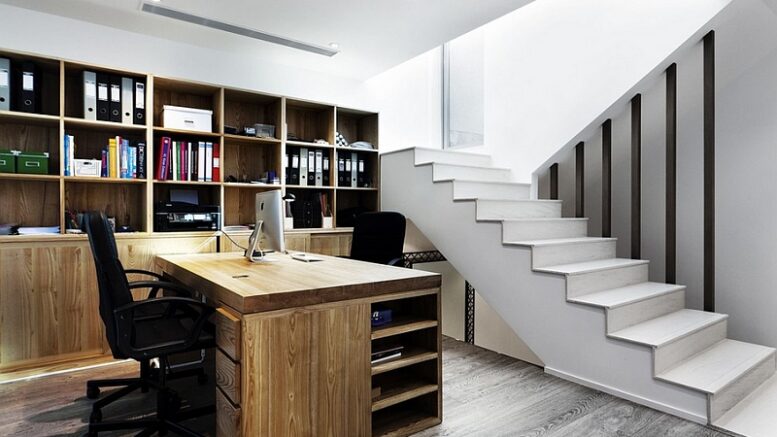Sometimes working in an office can be unconventional. Travelling everyday between rush hour, traffic or getting the kids in time can quickly become old and unmotivating.
Surprisingly, many business owners start on their kitchen table, not in an office in the city.
Then, overtime, a home office is made to accommodate business expansion.
While it may seem very simple to make an office at home, there is a lot more to consider than many assume. It’s not as simple as putting a desk in a room with a laptop, as this environment won’t deliver the best levels motivation to drive your business forward. A home office needs to be clean and tidy, however productive, enticing and functional.
Inspect Your Home Space
When creating an (at home) office, the first thing to consider is the amount of room that is available as well as the standard of the space. It is important to look into whether there is a need for a waterproofing system, new flooring such as Epoxy Flooring, or a new ceiling and to check for leaks.
This would be a good time to take measurements of the entire area too, as it will allow builders or decorators to know what they’re going to work with, before they begin.
Why You Should Choose The Basement
It goes without saying that the basement in any home is the one room that is often overlooked as a usable space. Usually it is of a fairly large size, with lots of possibilities of what it could become. The space and opportunities are often dismissed due to it being either damp, dark, or just overall unwelcoming.
However, the basement is actually one of the best options for the location of your at home office. It is far enough away from any of the rest of the household – providing peace and quiet. It is also a blank canvas, so you have a whole room to be creative with interior design, and do exactly what you want, usually with a free reign of building adjustments as the space is likely to be rather open and square.
Look past what the basement looks like now, and use your imagination to see what it could become.
Make The Most Of The Available Space
Once the area has been assessed, it is important to focus on the decor and furniture that will go into the office. It is beneficial to do this before construction begins as it could highlight a need for more space, or whether in set appliances such as the electrics or plumbing need to be moved.
This will also avoid disappointment as you are more likely to meet with your exact furniture requirement while the basement is still in a shell form. Buying time to play about with layouts and sizes.
Make drawings or plans on where items will be placed, with measurements too. This will enable you can see how much room is left once the perfect set up has been created.
Have Functional Lighting 
The basement is usually one of the last options for creating a workspace as they have a reputation for being dark and damp. Nothing that a some good led lighting knowhow and some damp proofing products can’t fix, so this clearly does not have to be the case.
Combining practical with inviting and warm lighting is a great way to make the office feel like part of the home, yet still a motivational work space. This is particularly important if you will be inviting clients into the office as well as for your wellbeing. The area needs to be comfortable, enticing and practical.
A combination of windows and artificial lighting is a great way to make the office feel fresh and open. The aim is to make the room feel as far away from a basement as possible. Adding areas where you can bring in the outside will make it feel like you are in a normal room, rather than underneath the house.
Make It Functional
While working, it is better to be away from distractions that can interrupt workflow as this can impact the amount of work produced by the end of the day.
Although it may not seem obvious, something as simple as getting up to get a new pen, or having to leave the room to answer the phone, interrupts workflow. The longer that is spent away from your workstation the more difficult it is to get back into that same headspace.
To avoid this, have all of the important items close to where the desk is situated. For example, if the phone will be used regularly, having one on the desk will avoid you having to leave the room. Having the printer with paper behind the desk, so you do not have to run upstairs and be enticed by the comfortable sofa and TV, that can put you off coming back into work is another example.
If the space is planned out right, it won’t be difficult to have everything needed right in front of you, which will aid to create great work by the end of the day, with no interruptions or unneeded time away from the office.
Consider Budget
It can be a fun project to get stuck into, the design, planning and decor a new space. But, it is easy to get overwhelmed and pay for unnecessary items and waste money that could eat into your business profits.
A practical way to save money is to recycle. It is likely there is already a computer, chair, printer and books in your home that you can utilise in the office without having to buy new.
Be frugal. It is acceptable to go to charity shops or cheap online marketplaces to get good deals on desks or furnishings. Then over time, when business has grown, you can invest in sophisticated, rich decor, or perhaps a commission a piece of office artwork.
Summary
As a whole, creating an at home office can be difficult, with many things to take into consideration. However, the investment will be beneficial and less costly than renting office space. It will also have the added bonus of adding value to your home.
All in a good day’s work without even leaving your home!

Be the first to comment on "Best Steps To Creating A Basement Office"